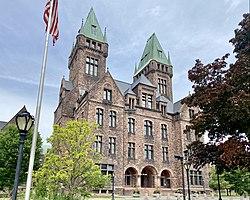| Richardson Olmsted Campus | |
|---|---|
 | |
 | |
| Former names | Buffalo State Asylum for the Insane, Buffalo State Hospital, Richardson Olmsted Complex, Hotel Henry |
| Alternative names | The Richardson Hotel |
| General information | |
| Status | Used as a hotel |
| Location | 444 Forest Avenue, Buffalo, New York 14222 |
| Coordinates | 42°55′43″N 078°52′55.1″W / 42.92861°N 78.881972°W |
| Named for | Henry Hobson Richardson |
Richardson Olmsted Complex | |
| Area | 93 acres (38 ha) |
| Built | Cornerstone placed in 1872. Finished in 1895. |
| Architect | Henry Hobson Richardson |
| Architectural style | Richardsonian Romanesque |
| NRHP reference No. | 73001186 |
| Significant dates | |
| Added to NRHP | January 12, 1973[1] |
| Designated NHL | June 24, 1986[2] |
| Renovated | 2006-2023 |
| Other information | |
| Number of rooms | 88 |
The Richardson Olmsted Campus in Buffalo, New York, United States, was designated a National Historic Landmark in 1986.[2][3] The site was designed by the American architect Henry Hobson Richardson in concert with the famed landscape team of Frederick Law Olmsted and Calvert Vaux in the late 1800s, incorporating a system of treatment for people with mental illness developed by Dr. Thomas Story Kirkbride known as the Kirkbride Plan. Over the years, as mental health treatment changed and resources were diverted, the buildings and grounds began a slow deterioration. By 1974, the last patients were removed from the historic wards. On June 24th, 1986, the former Buffalo State Asylum for the Insane was added to the National Historic Landmark registry. In 2006, the Richardson Center Corporation was formed to restore the buildings.
Today, the Richardson Olmsted Campus is being converted, beginning with the now open Hotel Richardson within the Towers Building and two flanking buildings (about one-third of the Campus). The Hotel Richardson also includes Cafe Calvert, Bar Vaux, and their new restaurant Cucina. The remaining buildings have been stabilized by the Richardson Center Corporation, with a plan by new developer Douglas Jemal to complete restoration.
Future plans for the site include the construction of a new museum in Buffalo's cultural corridor, known as the Lipsey Architecture Center Buffalo. The museum will focus on the city's rich architectural history and collection of now-preserved buildings.
- ^ "National Register Information System". National Register of Historic Places. National Park Service. July 9, 2010.
- ^ a b "Buffalo State Hospital". National Historic Landmark summary listing. National Park Service. September 18, 2007. Archived from the original on May 2, 2008.
- ^ "Cultural Resource Information System (CRIS)" (Searchable database). New York State Office of Parks, Recreation and Historic Preservation. Retrieved April 1, 2016. Note: This includes T. Robins Brown (August 1972). "National Register of Historic Places Registration Form: Buffalo State Hospital" (PDF). Retrieved April 1, 2016., Caroline Pitts (n.d.). "National Register of Historic Places Registration Form: Buffalo State Asylum for the Insane (State Lunatic Asylum)" (PDF). Retrieved April 1, 2016., and Accompanying three photographs
© MMXXIII Rich X Search. We shall prevail. All rights reserved. Rich X Search



